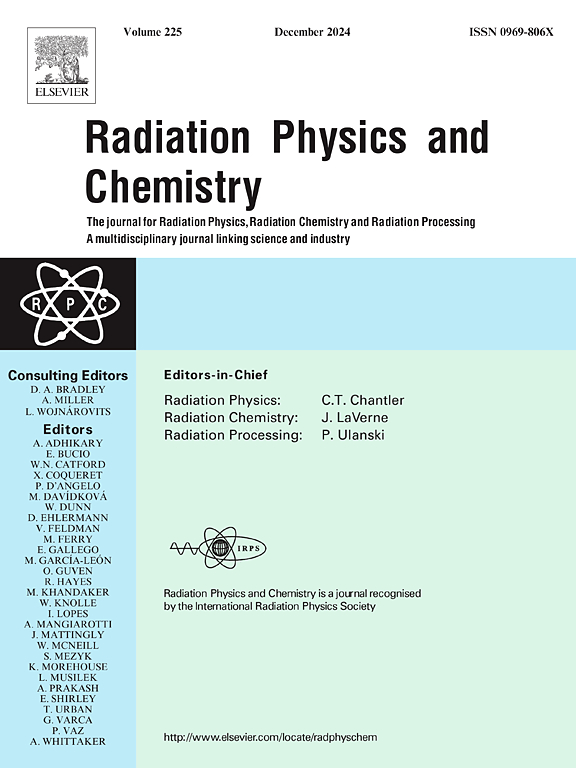IF 2.8
3区 物理与天体物理
Q3 CHEMISTRY, PHYSICAL
引用次数: 0
摘要
本研究系统地探讨了添加 Ce 对铜铝锰基高温形状记忆合金(HTSMA)的热、结构和辐射屏蔽性能的影响。在不同成分中,Ce-III 的性能最为均衡,表现出优化的相变行为、微观结构细化和增强的伽马射线衰减。差示扫描量热仪(DSC)分析表明,Ce-III 的转变温度较低,奥氏体开始(As)和结束(Af)温度分别为 378.13 ℃ 和 429.75 ℃,马氏体开始(Ms)和结束(Mf)温度分别为 402.52 ℃ 和 341.91 ℃,这表明其热稳定性得到了改善。微观结构分析表明,由于 Ce 的位错钉扎效应,晶粒明显细化,这有助于提高强度和辐射衰减。X 射线衍射(XRD)图证实形成了富含 Ce 的金属间相,如 Mn1.15Cu3.85Ce 和 Cu8Ce4,从而提高了密度和光子相互作用概率。Ce-III 合金表现出优异的线性衰减系数和较低的半值层,增强了其作为辐射屏蔽材料的有效性。可以得出结论,Ce-III 是一种最佳成分,具有结构稳定性、相变控制和增强辐射屏蔽能力的协同组合,是核和高辐射应用的理想候选材料。本文章由计算机程序翻译,如有差异,请以英文原文为准。
Effects of Trace Rare Earth (TRE) additions on thermal, crystal structure, and radiation shielding properties of CuAlMn high-temperature S-M alloys: A closer look at Cerium effect
This study systematically investigates the effect of Ce addition on the thermal, structural, and radiation shielding properties of CuAlMn-based high-temperature shape memory alloys (HTSMAs). Among the different compositions, Ce-III demonstrated the most balanced performance, exhibiting optimized phase transformation behavior, microstructural refinement, and enhanced gamma-ray attenuation. Differential Scanning Calorimetry (DSC) analysis revealed that Ce-III exhibited lower transformation temperatures, with austenite start (As) and finish (Af) temperatures of 378.13 °C and 429.75 °C, respectively, and martensite start (Ms) and finish (Mf) temperatures of 402.52 °C and 341.91 °C, suggesting improved thermal stability. Microstructural analysis indicated significant grain refinement, attributed to Ce's dislocation pinning effect, which contributed to enhanced strength and radiation attenuation. X-ray diffraction (XRD) patterns confirmed the formation of Ce-rich intermetallic phases, such as Mn1.15Cu3.85Ce and Cu8Ce4, which increased density and photon interaction probability. The Ce-III alloy exhibited superior linear attenuation coefficients and reduced half-value layer, reinforcing its effectiveness as a radiation shielding material. It can be concluded that Ce-III represents an optimal composition with a synergistic combination of structural stability, phase transformation control, and enhanced radiation shielding capabilities, making it a promising candidate for nuclear and high-radiation applications.
求助全文
通过发布文献求助,成功后即可免费获取论文全文。
去求助
来源期刊

Radiation Physics and Chemistry
化学-核科学技术
CiteScore
5.60
自引率
17.20%
发文量
574
审稿时长
12 weeks
期刊介绍:
Radiation Physics and Chemistry is a multidisciplinary journal that provides a medium for publication of substantial and original papers, reviews, and short communications which focus on research and developments involving ionizing radiation in radiation physics, radiation chemistry and radiation processing.
The journal aims to publish papers with significance to an international audience, containing substantial novelty and scientific impact. The Editors reserve the rights to reject, with or without external review, papers that do not meet these criteria. This could include papers that are very similar to previous publications, only with changed target substrates, employed materials, analyzed sites and experimental methods, report results without presenting new insights and/or hypothesis testing, or do not focus on the radiation effects.
 求助内容:
求助内容: 应助结果提醒方式:
应助结果提醒方式:


